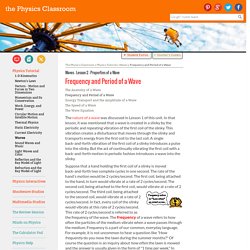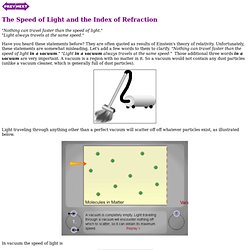

Guitar Oscillations Captured with iPhone 4. Frequency and Period of a Wave. The nature of a wave was discussed in Lesson 1 of this unit.

In that lesson, it was mentioned that a wave is created in a slinky by the periodic and repeating vibration of the first coil of the slinky. This vibration creates a disturbance that moves through the slinky and transports energy from the first coil to the last coil. A single back-and-forth vibration of the first coil of a slinky introduces a pulse into the slinky. But the act of continually vibrating the first coil with a back-and-forth motion in periodic fashion introduces a wave into the slinky. Suppose that a hand holding the first coil of a slinky is moved back-and-forth two complete cycles in one second. At a rate of 2 cycles/second. The quantity frequency is often confused with the quantity period. Frequency and period are distinctly different, yet related, quantities. Since the symbol f is used for frequency and the symbol T is used for period, these equations are also expressed as:
CYMATICS: Science Vs. Music - Nigel Stanford. DJ Pollyfonika. Su ve sesten oluşan mükemmel gösteri - Samanyoluhaber.com. DOMİNO DANCİNG ;)))) - MEQAPOLİS Doktor Ziya ilə. AFL Selected Responses Questions_Answer Key. AFL Selected Responses Questions. Wave Science Standards. SoundwavesLab. Www.wonderworksonline.com/Education/1-PDF's/4-Science Lesson Plans/Light Reflection & Refraction Lesson Plan.pdf. Refraction. The Speed of Light and the Index of Refraction. "Nothing can travel faster than the speed of light.

" "Light always travels at the same speed. " Have you heard these statements before? They are often quoted as results of Einstein's theory of relativity. Unfortunately, these statements are somewhat misleading. Let's add a few words to them to clarify. Light traveling through anything other than a perfect vacuum will scatter off off whatever particles exist, as illustrated below.
In vacuum the speed of light is This vacuum speed of light, c, is what the statements from relativity describe. That's not to say that nothing ever travels faster than light. N = c/v The index of refraction of some common materials are given below. Values of n come from the CRC Handbook of Chemistry and Physics Those materials with large indices of refraction are called optically dense media. Frequency, Wavelength, and Pitch. Waves & Sound - Mrs. Barnett Dreyfuss. Www.effinghamschools.com/cms/lib4/GA01000314/Centricity/Domain/702/489-494.pdf.
Lesson 44: Frequency, Wavelength, & Amplitude. Now that you know something about the properties of the two main types of waves (Lesson 43), we need to make sure that you can look at individual characteristics that waves can have.

Not all waves are created equal! You need to be able to see the specific “faces” that each wave can have, based on three important characteristics: frequency, wavelength, and amplitude. Frequency When we first started looking at SHM we defined period as the amount of time it takes for one cycle to complete... seconds per cycle Frequency is the same sort of idea, except we’re just going to flip things around. Since frequency and period are exact inverses of each other, there is a very basic pair of formulas you can use to calculate one if you know the other… It is very easy to do these calculations on calculators using the x-1 button. Example 1: The period of a pendulum is 4.5s. The period means that it will take 4.5 seconds for the pendulum to swing back and forth once. Wavelength Figure 1 Figure 2 Figure 3. The Law of Conservation of Energy. As of July 1, 2013 ThinkQuest has been discontinued.

We would like to thank everyone for being a part of the ThinkQuest global community: Students - For your limitless creativity and innovation, which inspires us all. Teachers - For your passion in guiding students on their quest. Partners - For your unwavering support and evangelism. Parents - For supporting the use of technology not only as an instrument of learning, but as a means of creating knowledge. We encourage everyone to continue to “Think, Create and Collaborate,” unleashing the power of technology to teach, share, and inspire.
Best wishes, The Oracle Education Foundation.